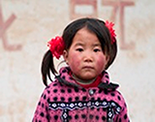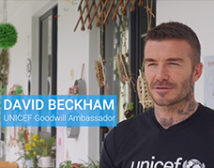It's all about determination and persistence against the odds, believes Zhang Ke. "You can realize your dreams as long as you persist," says the 11-year-old.
 ©UNICEF/China/2006 ©UNICEF/China/2006
A boy reads a folk tale book. |
"You see, if the youngest brother had run away like his elder brothers on that night, he would never have married the beautiful princess," says the fifth-grader from Run'an Public School in China's eastern Anhui Province.
The youngest brother Zhang Ke refers to is the character in a fairy tale named The Princess in the Glass Mountain, which tells the story of the brave son of a farmer who survives earthquakes to capture three horses, three suits of armour and the heart of a beautiful princess.
Schoolmate Guo Shengcheng has a different take. "Although the youngest is not as smart as his two elder brothers, he knows how to stick at stuff and copes with all the misfortune until finally he is the happiest," he says.
"It tells me that sometimes things are not what they seem. Don't be sad because you're not smart enough. Sometimes you can be happier than others."
No, no, no. Qi Yang doesn't agree with that version at all.
"I think the little brother is selfish. He should share what he has gained with his elder brothers, then all of them can be happy."
"After all, they're one family and they should stick together through thick and thin."
Shengcheng was more interested in the story of a pancake who survives several close shaves on his journey from the oven, but at the final hurdle is tricked by a cunning pig.
"The pancake is too stupid. If he had more knowledge and experience, he would never end his life inside a stupid pig," concludes the 11-year-old.
These discussions are taking place through blogging on the Internet, between children in the pilot schools of a distance education project sponsored by Citigroup Foundation and implemented by National Center for Educational Technology (NCET) and UNICEF. The blog about fairy tales is part of this project's website (www.isnet.org.cn) using tele-collaboration to improve children's reading, listening and imagination skills – all important aspects of a child's learning and development.
The fairy tales they are discussing originate in Norway. A total of 2,500 copies of a book called, "Norwegian Fairy Tales Book for Children" were presented by the Royal Norwegian Embassy to China to the United Nations Children's Fund (UNICEF) in 2005, and then distributed to more than 700 project schools and kindergartens mainly in rural western China, making it accessible to about 250,000 children.
According to Ola Breidal, Culture Attaché of the Royal Norwegian Embassy to China, a young Chinese diplomat named Zhong Shujia working for the Chinese embassy in Oslo translated these fairy tales from Norwegian to Chinese. The tales themselves were passed down through generations by word-of-mouth in the Norwegian countryside. They were not written down until the 19th century, when Peder Christian Asbjørnsen and Jørgen Moe visited hundreds of villages, transcribing the stories as told to them by local people. And now they have found their way to a country far far away from Norway – they are in China.
Lack of storybooks has remained an obstacle for the rural schools of China who are often unable to purchase storybooks. For instance, in the three project schools of Jingxi County, Guangxi Zhuang Autonomous Region, an average student has only nine story books to read in the school's reading room, against the national standard of 15 books required to complete the nine-year compulsory education. All the books of these three schools were purchased before 1999 owing to the meager school resources. They also fail to meet the national demand of increasing storybooks by 5 percent each year.
The children of these schools are now enjoying this rare collection of Norwegian folk tales, first published in 1841 and today regarded as one of Norway's national treasures. The stories of fearsome trolls and powerful kings, of beautiful princesses and crafty heroes, have left their impact upon generations of Norwegians and are still widely read, says Breidal.
"We know that students in China's rural areas lack both original textbooks and story books. So we cooperated with UNICEF to send more books to them, and help them enrich their school life," he says. "No matter where they are from, children know how to appreciate fairy tales and they never get enough stories."
He said when he was a child, he once read a Chinese fairy tale of a fisherman fishing at the threshold of the Yangtse River wearing a rattan rain cape with a crane on his shoulder.
"This was my first impression of China, and I thought the country was so fascinating."
He hopes these interesting Norwegian stories "will make Chinese children develop a curiosity for Norway and stimulate their imagination and creativity."
Indeed. Before the 36 students in the fifth grade of Run'an Public School received their five copies of the book at the end of October 2005, they had no idea about Norway.
"I first mistook Norway for Denmark, because I had read the Hans Christian Anderson Fairy Tales and I supposed that those foreign countries which produce fairy tales must all be alike," says 11-year-old Wang Yu.
The stories sparked Yu's curiosity and he went searching on the Internet.
"I found out the location, the national flag and the emblem of Norway. More importantly, I calculated that the total land area of Norway equals that of three Anhui Provinces and ten Taiwans," says Yu.
Three times a week, students listened to their teacher read the story, then wrote it up in their own words. They drew illustrations and even acted as characters in the story. They also shared their feelings on the Internet.
"Norway's folk tales are easy to understand but full of imagination," says 11-year-old Zhang Danfeng. "It's easy to find out the in-depth meaning behind each story and easy to remember, because the story is funny. I feel it's fun, not tiring, reading them."
But he also finds some stories a bit repetitive. "Although they are long, they don't contain much solid plot. They just portray different characters doing the same thing and getting different results," he observes, thinking that they might be more suitable for children younger than him.
For students of the Pilot Elementary School of Jingxi County of China's western Guangxi Zhuang Autonomous Region, also a project school, where the annual income per capita for the county is 1,280 yuan (US$ 160), these Norwegian folk tales are more than stories, as for six years since 1999 there had been no new books entering the school's reading room for the 1,606 elementary school students.
"It (the book) tells stories about the countryside which connect with our hometown," says 11-year-old Nong Guilu of Jingxi Pilot Elementary School. "But why are the rural areas in Norway so different from ours? It's so beautiful and clean from the pictures I saw in the book. When can our hometown be like that?"
Guilu admits she rarely had a chance to read foreign fairy tales. "I used to read Chinese traditional legends like the Monkey King," she says. "But that's far removed from my life. The Norwegian fairy tales tell stories about ordinary farmers, children in farmhouses, animals in the fields -- which made me feel that fairy tales can happen around me."
"These fairy tales just open a door for Chinese children to better understand a different culture, way of living and value system," says Prof. Xu Xiaodong from the School of Educational Information and Technology of Guangzhou-based South China Normal University, who is also the project monitoring expert.
"Children imagine themselves in others' shoes and recognize that differences create variety in the world. When they grow up, they are less likely to be biased or intolerant towards other cultures."
"Folk and fairy tales unify children and make the world feel smaller. They speak the same language all around the world, and teach you skills for life," says UNICEF project official Annette Nyquist, who as a native Norwegian, heard these folk tales even before she was able to read.
"The ideals and values portrayed in these fairy tales are similar to what we find in Chinese values, like making use of your own capacity to do good to and respect others, to be brave and independent and make decisions for life," she says.
The fairy tales have influenced teachers, too.
"When I read the stories to the students, I was reminded of those innocent years when I was a carefree child, reading fairy tales, longing to grow up and always believing that everything will turn out happily ever after," says Chen Feng, a distance education teacher in Run'an.
"Actually in this changing society, these ideals should not be forgotten and should be constantly reinforced. A child-like heart, to some degree, can be much stronger."
This fairy tales theme in this distance education tele-collaborative learning project also helps to achieve a high-quality education, notes Prof. Xu. "The project asks students to use their eyes, ears, hands, mouths and hearts together to take an active part in interpreting the folk tales, far more effective than merely sitting in the classroom being stuffed with knowledge like a Beijing Duck."
Nyquist agrees.
"It (the project) widens your horizon and builds interest to explore and the capacity to express. That is important both in school and later in life," she says.
But there's a question that ponders Chen Jiajia of Run'an Public School.
"I want to know how a king lives in Norway. It is so strange that a king still exists in reality, not only in fairy tales," says the 11-year-old girl. So inspired is she, that she says, "I want to tell the King that I love these folk tales and in future, I would like to even write better ones!"
(by Rong Jiaojiao, China Features)





























